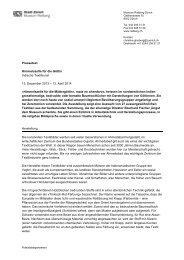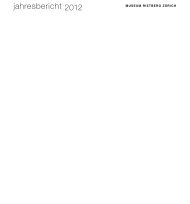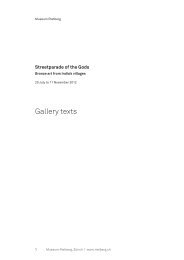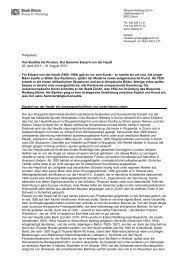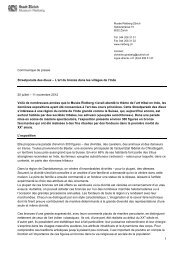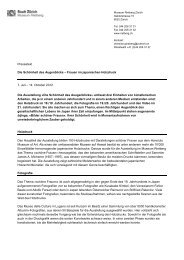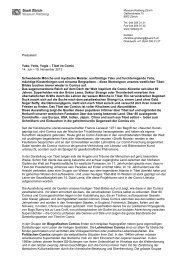1.1 eduard von der heydt - Museum Rietberg
1.1 eduard von der heydt - Museum Rietberg
1.1 eduard von der heydt - Museum Rietberg
You also want an ePaper? Increase the reach of your titles
YUMPU automatically turns print PDFs into web optimized ePapers that Google loves.
6.3<br />
johannes<br />
itten, gründungsdirektor<br />
des museums<br />
Johannes Itten (1888–1967) war Künstler,<br />
Bauhausmitbegrün<strong>der</strong>, Kunstpädagoge und <strong>Museum</strong>sleiter.<br />
Er erkannte das grosse Potenzial <strong>der</strong> aussereuropäischen<br />
Sammlung Von <strong>der</strong> Heydt und war die treibende Kraft, die zur<br />
Gründung des <strong>Museum</strong>s <strong>Rietberg</strong> führte.<br />
Drei Aufgaben hatte er dabei zu lösen: Er<br />
musste <strong>von</strong> <strong>der</strong> Heydt vom Zürcher <strong>Museum</strong>sprojekt über-<br />
zeugen, was aufgrund <strong>der</strong> komplexen Persönlichkeit des<br />
Sammlers alles an<strong>der</strong>e als einfach war. Er musste den Umbau<br />
<strong>der</strong> herrschaftlichen Villa Wesendonck in ein neutrales,<br />
mo<strong>der</strong>n wirkendes <strong>Museum</strong> vorantreiben, das neue <strong>Museum</strong><br />
einrichten und die Abstimmungskampagne für die <strong>Museum</strong>sgründung<br />
anführen. Und schliesslich die wohl schwierigste<br />
Aufgabe: Er musste bei allen Museen in Europa und Amerika<br />
die Leihgaben, die <strong>von</strong> <strong>der</strong> Heydt ihnen überlassen hatte,<br />
zurückfor<strong>der</strong>n. Kein <strong>Museum</strong> sah dies gerne. Einige verweigerten<br />
die Rückgabe und waren erst nach Verhandlungen<br />
dazu bereit. Die in den USA deponierten Leihgaben wurden<br />
als deutsches Feindesgut beschlagnahmt – und sind bis<br />
heute nicht zurückgegeben worden. Da<strong>von</strong> abgesehen aber<br />
war <strong>der</strong> Direktor sehr erfolgreich, und das <strong>Museum</strong> <strong>Rietberg</strong><br />
ist, wie Hans Curjel schrieb, «ein wahres Geschenk Ittens<br />
an die Stadt Zürich».<br />
6.3<br />
johannes itten,<br />
founding director<br />
of museum<br />
rietberg<br />
Johannes Itten (1888–1967) was an artist, cofoun<strong>der</strong><br />
of Bauhaus, art educator and museum director. He<br />
recognised the great potential of the non-European collection<br />
of <strong>von</strong> <strong>der</strong> Heydt and was the leading force in the establishment<br />
of <strong>Museum</strong> <strong>Rietberg</strong>.<br />
To do this he had to complete a few initial<br />
tasks. He had to win over <strong>von</strong> <strong>der</strong> Heydt to supporting the museum<br />
project, something which was anything but easy given<br />
the collector’s complex personality. He had to drive forward<br />
the conversion of the stately Villa Wesendonck into a neutral<br />
looking mo<strong>der</strong>n museum; he had to furnish the new museum,<br />
and lead the campaign to win the support of Zurich voters.<br />
And finally, there was a last task, probably the most difficult<br />
one: he had to contact all the museums in Europe and<br />
the United States to which <strong>von</strong> <strong>der</strong> Heydt had loaned objects<br />
and recall them. None of the museums was happy about this.<br />
Some refused and had to be persuaded through lengthy negotiations.<br />
Loans in the US were confiscated as German enemy<br />
goods and to this day have not been returned. But apart<br />
from this, the director was very successful and <strong>Museum</strong><br />
<strong>Rietberg</strong> is, in the words of Hans Curjel, “a true gift by Itten to<br />
the city of Zurich”.<br />
6.3<br />
johannes itten,<br />
directeur<br />
fondateur du<br />
musée rietberg<br />
Artiste, cofondateur du Bauhaus, professeur<br />
d’art et excellent pédagogue, directeur de musée, Johannes<br />
Itten (1888–1967) avait reconnu l’énorme potentiel que représentait<br />
la collection d’art extra-européen d’Eduard <strong>von</strong><br />
<strong>der</strong> Heydt. Il joua un rôle moteur dans cette dynamique qui<br />
aboutit à la création du musée.<br />
Itten dut, pour cela, résoudre nombreuses<br />
tâches: tout d’abord, convaincre <strong>von</strong> <strong>der</strong> Heydt du projet de<br />
musée zurichois, ce qui, en raison de la personnalité complexe<br />
du collectionneur, n’était pas chose aisée; puis, faire avancer<br />
la transformation de la majestueuse Villa Wesendonck en un<br />
musée neutre et mo<strong>der</strong>ne; aménager le nouveau bâtiment et<br />
mener la campagne de votation pour la création du Musée<br />
<strong>Rietberg</strong>; enfin, tâche sans doute la plus difficile, réclamer<br />
à tous les musées européens et américains les prêts qui leur<br />
avaient été confiés par le baron <strong>von</strong> <strong>der</strong> Heydt. Aucun musée<br />
ne voyait la chose d’un bon œil. Certains, qui refusaient<br />
de rendre les œuvres, ne finirent par y consentir qu’après<br />
d’âpres négociations. Les prêts déposés aux Etats-Unis<br />
furent mis sous séquestre, en tant que biens appartenant<br />
à l’ennemi allemand – ils n’ont toujours pas été restitués.<br />
Sinon, Johannes Itten eut beaucoup de succès dans ses fonctions<br />
de directeur, et l’on peut dire que le Musée <strong>Rietberg</strong> est,<br />
ainsi que l’écrit Hans Curjel, «un véritable cadeau qu’Itten a<br />
fait à la ville de Zurich».<br />
Johannes Itten, <strong>Museum</strong> <strong>Rietberg</strong> Zürich, 1957<br />
(<strong>Museum</strong> <strong>Rietberg</strong> Zürich, Archiv)






